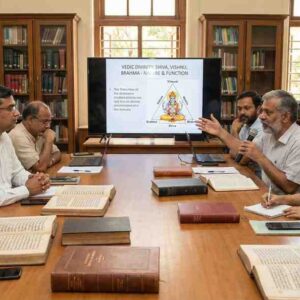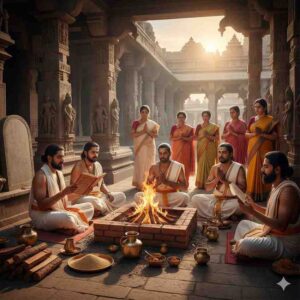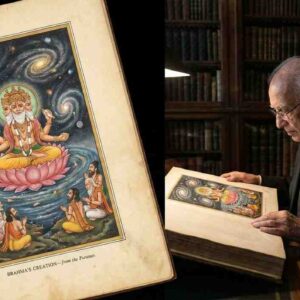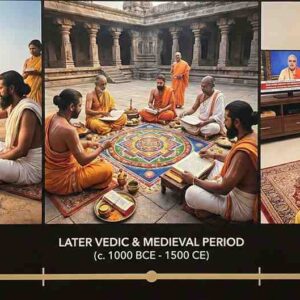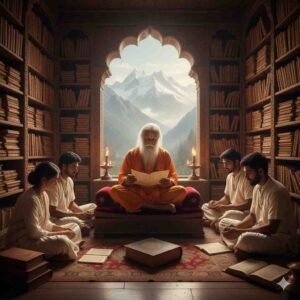TheVedasandShastrasare cornerstones of Indian intellectual and spiritual heritage, offering insights into cosmic truths, ethical living, and societal organization. While the Vedas are revered asShruti(divine revelations), the Shastras, categorized asSmriti(human interpretations), serve as practical guides for applying Vedic principles in daily life. This duality often raises the question: are Vedic narratives and Shastric analysis complementary frameworks for wisdom, or do they present contradictory perspectives?
The Vedic Tradition: Cosmic Narratives and Eternal Truths
TheVedas—Rigveda,Yajurveda,Samaveda, andAtharvaveda—are considered the oldest spiritual texts in Hinduism. They emphasize universal principles, metaphysical concepts, and the alignment of human actions withcosmic order (Rita).
Key Features of Vedic Narratives:
- Spiritual Orientation: The Vedas explore profound concepts like Brahman (ultimate reality) and Atman (self), providing a philosophical foundation.
- Ritualistic Core: They prescribe detailed rituals and sacrifices (yajnas) to maintain harmony between humans and the cosmos.
- Mythological Context: Hymns in the Rigveda, for example, narrate stories of deities like Agni (fire) and Indra (rain), symbolizing humanity’s connection to nature and divinity.
The Vedas are timeless and universal, offering a framework that transcends cultural and temporal boundaries.
Shastric Analysis: Practical Application and Ethical Guidance
TheShastras, such as theDharma Shastras,Arthashastra, andNatyashastra, interpret and expand upon Vedic principles. They address practical issues related to law, governance, and culture, adapting Vedic wisdom to societal needs.
Key Features of Shastric Analysis:
- Ethical and Social Frameworks: Texts like the Manusmriti outline moral duties (Dharma) and social hierarchies, translating Vedic ideals into actionable norms.
- Governance and Economy: The Arthashastra applies Vedic principles of duty and justice to statecraft and administration.
- Cultural Expressions: The Natyashastra extends Vedic ideas of cosmic rhythm into the performing arts, demonstrating the intersection of spirituality and creativity.
Unlike the Vedas, the Shastras are dynamic, evolving with societal changes and offering contextual solutions.
Complementary or Contradictory?
Complementary Aspects:
- Shared Foundation: Both the Vedas and Shastras are rooted in the pursuit of Dharma, ensuring cosmic and social harmony.
- Theory and Practice: The Vedas provide the philosophical foundation, while the Shastras translate these principles into practical guidelines for governance, ethics, and culture.
- Interdependence: Rituals prescribed in the Vedas are contextualized through Shastric ethics, making them relevant to societal needs.
For example, theBhagavad Gita, often considered a Shastric text, bridges Vedic spiritual ideals with practical philosophy, emphasizing bothKarma Yoga(action) andJnana Yoga(knowledge).
Potential Contradictions:
- Timeless vs. Contextual: The eternal nature of Vedic truths may conflict with the evolving interpretations of the Shastras.
- Inclusivity vs. Exclusivity: While the Vedas emphasize universal principles, some Shastric texts, such as the Manusmriti, codify rigid social hierarchies that are often critiqued for their exclusivity.
- Spiritual vs. Material Focus: The Vedas prioritize spiritual alignment, whereas the Shastras often emphasize practical concerns like governance and social order.
Relevance in Modern Times
Understanding the interplay between the Vedas and Shastras is crucial for addressing contemporary challenges:
- Ethics and Governance: Insights from the Arthashastra can inform modern policymaking, while Vedic teachings inspire sustainable and ethical practices.
- Cultural Preservation: The integration of Vedic spirituality and Shastric pragmatism ensures the continuity of cultural traditions while allowing for adaptation.
- Philosophical Inquiry: The timeless questions posed in the Vedas, contextualized through Shastric analysis, remain relevant for personal and societal growth.
Conclusion
The Vedic narratives and Shastric analyses are best understood as complementary, with each playing a vital role in shaping Indian thought. While the Vedas provide a universal and eternal blueprint for spiritual and cosmic understanding, the Shastras adapt this wisdom to the practical realities of human life. By harmonizing these approaches, individuals and societies can draw upon a rich heritage that balances timeless truths with contextual relevance, ensuring their enduring significance in an evolving world.



